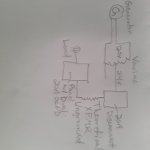200212-1151 EST
Travis:
I believe your goal is to run an experiment on an experimental transformer of your own making.
From the discussion so far I don't believe you have had either a high school chemistry or physics class. In either case you would have learned how to define. describe, do, and report on an experiment.
You have not defined your experiment.
A formal physics experiment and report would consist of the following parts:
1. Purpose --- here you define what is the purpose of the experiment. As an example --- how does the v-i curve of a 1N4148 diode vary as a function of ambient air temperature in a horizontal position with no forced air cooling?
2. Equipment --- a list of everything needed. For example --- a temperature chamber of adequate size, a means to change temperature, a thermometer, a voltmeter, a milliammeter, a means to adjust a steady current, and pencil and paper.
3. Procedure --- how to perform the experiment.
4. Data from running the experiment.
5. Conclusions.
You may do much of the above in your head. But you have told us virtually nothing about the experiment. Initially you said the item to be tested was an autotransformer. But later I think you changed it to an isolation transformer, but not using the term isolation.
You have not told us what you want to learn about the transformer under test. That means we have no ides what will be connected to the transformer as a load or test equipment.
What you have done is get all hung up on NEC rules. That is just noise, or instrumentation problems to your experiment.
You need an insulated table on which to locate your transformer under test, and other components of the test.
Apparently you want an AC 60 Hz sine wave voltage source as the input to your experiment. For this you are using a Variac. Does it need to be adjustable in amplitude? I expect it should be. What do you need as a source impedance? Does the source need to be isolated? I would like it to be, but when i run experiments I tend to work around that problem other ways.
You are hung up on NEC rules, and you don't have some clear definitions of words, and electrical circuit theory.
Forget the NEC stuff for the moment, and tell us about the experiment. Then we can work around NEC later. For the moment assume you have an isolated adjustable AC sine wave source. This is drawn on a diagram as a circle with a single cycle sine wave in the middle, one wire from the top, and one from the bottom.
What type of instruments are used on the load will determine the need for isolation of the input power, or how to work around a non-isolated source.
.



